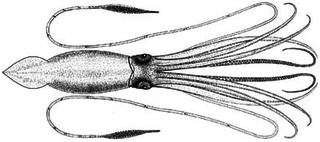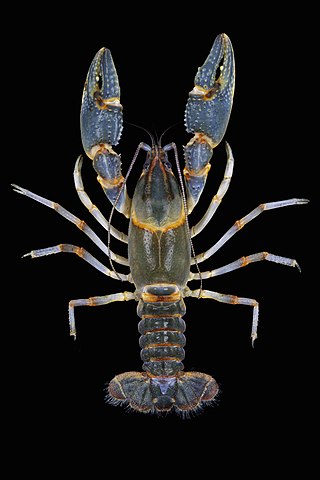
Crayfish are freshwater crustaceans belonging to the clade Astacidea, which also contains lobsters. In some locations, they are also known as baybugs, crabfish, crawfish, crawdaddies, crawdads, freshwater lobsters, mountain lobsters, mudbugs, rock lobsters, signal crawfish, or yabbies. Taxonomically, they are members of the superfamilies Astacoidea and Parastacoidea. They breathe through feather-like gills. Some species are found in brooks and streams, where fresh water is running, while others thrive in swamps, ditches, and paddy fields. Most crayfish cannot tolerate polluted water, although some species, such as Procambarus clarkii, are hardier. Crayfish feed on animals and plants, either living or decomposing, and detritus.

The giant squid is a species of deep-ocean dwelling squid in the family Architeuthidae. It can grow to a tremendous size, offering an example of abyssal gigantism: recent estimates put the maximum size at around 12–13 m (39–43 ft) for females and 10 m (33 ft) for males, from the posterior fins to the tip of the two long tentacles. The mantle of the giant squid is about 2 m long, and the length of the squid excluding its tentacles rarely exceeds 5 m (16 ft). Claims of specimens measuring 20 m (66 ft) or more have not been scientifically documented.

Deinosuchus is an extinct genus of alligatoroid crocodilian, related to modern alligators and caimans, that lived 82 to 73 million years ago (Ma), during the late Cretaceous period. The name translates as "terrible crocodile" and is derived from the Greek deinos (δεινός), "terrible", and soukhos (σοῦχος), "crocodile". The first remains were discovered in North Carolina in the 1850s; the genus was named and described in 1909. Additional fragments were discovered in the 1940s and were later incorporated into an influential, though inaccurate, skull reconstruction at the American Museum of Natural History. Knowledge of Deinosuchus remains incomplete, but better cranial material found in recent years has expanded scientific understanding of this massive predator.

Pacifastacus fortis is an endangered crayfish species endemic to Shasta County, California, where it is found only in isolated spots on the Pit River and Fall River Mills. The exact subpopulations for the Shasta Crayfish were discovered in 2004 through a genetic study that determined three different genetic clusters: Crystal Lake, the Big Lake group, and Thousand Springs.

The Tasmanian giant freshwater crayfish, also called Tasmanian giant freshwater lobster, is the largest freshwater invertebrate and the largest freshwater crayfish species in the world. The species is only found in the rivers below 400 metres (1,300 ft) above sea level in northern Tasmania, an island-state of Australia. It is listed as an endangered species on the IUCN Red List due to overfishing and habitat degradation, and it has been prohibited to catch the crayfish since 1998.

Procambarus clarkii, known variously as the red swamp crayfish, Louisiana crawfish or mudbug, is a species of cambarid crayfish native to freshwater bodies of northern Mexico, and southern and southeastern United States, but also introduced elsewhere, where it is often an invasive pest.

The Yangtze giant softshell turtle, also known commonly as the Red River giant softshell turtle, the Shanghai softshell turtle, the speckled softshell turtle, and Swinhoe's softshell turtle, is an extremely rare species of turtle in the family Trionychidae. It may be the largest living freshwater turtle in the world. The species is native to eastern and southern China and northern Vietnam. With a known population of only three individuals, and with the last females dying out, this species is considered functionally extinct.
Faxonius peruncus, the Big Creek crayfish, is a species of crayfish in the family Cambaridae. It is endemic to Missouri. The common name refers to Big Creek, where the original specimens were found.

The Nashville crayfish, Faxonius shoupi, is a freshwater crustacean native to the Mill Creek Basin in Nashville, Tennessee. Prior to August 2017, the species was called Orconectes shoupi. Faxonius shoupi is protected under the Endangered Species Act (ESA) as an endangered species. However, the crayfish has recently been put up for delisting by the United States Fish and Wildlife Service.

Pacifastacus nigrescens, the sooty crayfish, is an extinct species of crayfish in the family Astacidae. It was originally described in 1857 by William Stimpson from the area around San Francisco, where it was once common in the creeks surrounding San Francisco Bay. The signal crayfish, Pacifastacus leniusculus was introduced to California, probably in the 19th century, and since then, no sightings of P. nigrescens have been made; it is now believed to be extinct. Intensive searches of its former habitat have found that every site where it once occurred is now occupied by either the signal crayfish or Procambarus clarkii.
Barbicambarus cornutus is a species of crayfish found only in the Barren River and Green River systems of Tennessee and Kentucky. It is one of the largest crayfish in North America, reaching lengths of up to 9 inches (230 mm), and its antennae are distinctive in being fringed. Although it was first described in 1884, it was not seen again until the 1960s. The species is sometimes called the bottlebrush crayfish.

The colossal squid is part of the family Cranchiidae. It is sometimes called the Antarctic squid or giant cranch squid and is believed to be the largest squid species in terms of mass. It is the only recognized member of the genus Mesonychoteuthis and is known from only a small number of specimens. The species is confirmed to reach a mass of at least 495 kilograms (1,091 lb), though the largest specimens—known only from beaks found in sperm whale stomachs—may perhaps weigh as much as 600–700 kilograms (1,300–1,500 lb), making it the largest known invertebrate. Maximum total length has been estimated at 9–10 metres (30–33 ft). The colossal squid has the largest eyes of any known creature ever to exist, with an estimated diameter of 27 cm (11 in).

The year 2010 involved numerous significant scientific events and discoveries, some of which are listed below. The United Nations declared 2010 the International Year of Biodiversity.

The ghost shiner is a North American species of freshwater fish of the family Cyprinidae. It is generally characterized as being a small bodied, silvery and fusiform shaped cyprinid. Notropis buchanani is morphologically similar to and often mistaken for the Mimic Shiner, which is evident by its former classification as a subspecies of Notropis volucellus.

Faxonius immunis is a species of crayfish in the family Cambaridae. It is native to North America and it is an introduced species in Europe, where it lives along the Upper Rhine. Its common names include calico crayfish and papershell crayfish.
Procambarus liberorum is a species of crayfish in the family Cambaridae. It is endemic to the United States, where it occurs in Arkansas and Oklahoma. It is known commonly as the Osage burrowing crayfish.
Barbicambarus is a genus of freshwater crayfish found in Tennessee and Kentucky in the United States. It comprises two species:
Faxonius alabamensis, the Alabama crayfish, is a species of freshwater crayfish that lives in Alabama, Mississippi and Tennessee.
Faxonius maletae, sometimes called the Kisatchie painted crayfish or Kisatchie painted crawfish, is a species of crawdad in the Cambaridae family. The specific epithet maletae is in honor of the discoverer's wife, author Maleta M. Walls, who helped collect many of the original specimens. It was originally described as a subspecies of Orconectes difficilis, but later elevated to full species status. The common name refers to the Kisatchie National Forest, near where the original specimens were found in Bayou Santabarb.

Lacunicambarus freudensteini, the banded mudbug, is a species of North American burrowing crayfish found in Alabama and Mississippi.














